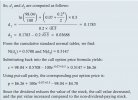Hi everyone! I have a question related to the BSM model.
When we calculate N(d1) and N(d2), we’re using cumulative normal table(Z-table).
but in this example it states that d1 = 0.1783 -> N(d1) = 0.5708 and d2 = 0.03688 -> N(d2) = 0.5147. Can someone explain why the results are different from the table? Thanks!
When we calculate N(d1) and N(d2), we’re using cumulative normal table(Z-table).
but in this example it states that d1 = 0.1783 -> N(d1) = 0.5708 and d2 = 0.03688 -> N(d2) = 0.5147. Can someone explain why the results are different from the table? Thanks!


